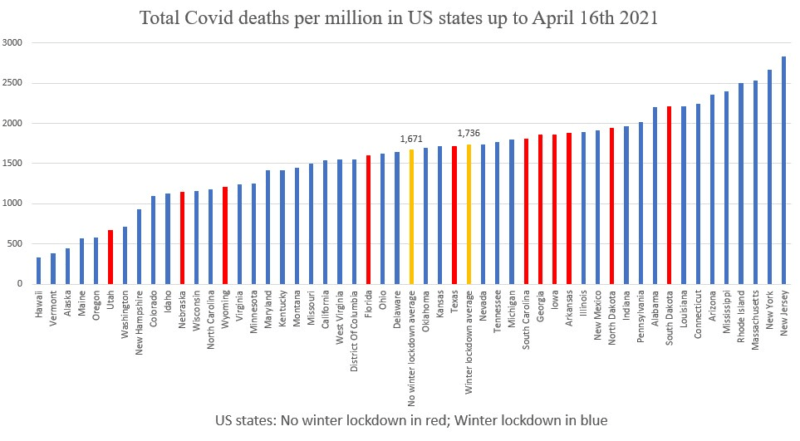The Lockdown Paradigm Is Collapsing

It’s taken much longer than it should have but at last it seems to be happening: the lockdown paradigm is collapsing. The signs are all around us.
The one-time hero of the lockdown, New York Governor Andrew Cuomo, has seen his support tank from 71% to 38%, along with ever more demands that he resign. Meanwhile, polls have started to favor Florida governor and lockdown opponent Ron DeSantis for influence over the GOP in the future. This remarkable flip in fortunes is due to the dawning realization that the lockdowns were a disastrous policy. DeSantis and fellow anti-lockdown governor Kristi Noem are the first to state the truth bluntly. Their honesty has won them both credibility.
Meanwhile, in Congressional hearings, Representative James Jordan (R-OH) demanded that Dr. Fauci account for why closed Michigan has worse disease prevalence than neighboring Wisconsin which has long been entirely open. Fauci pretended he couldn’t hear the question, couldn’t see the chart, and then didn’t understand. Finally he just sat there silent after having uttered a few banalities about enforcement differentials.
The lockdowners are now dealing with the huge problem of Texas. It has been fully open with no restrictions for 6 weeks. Cases and deaths fell dramatically in the same period. Fauci has no answer. Or compare closed California with open Florida: similar death rates. We have a full range of experiences in the US that allow comparisons between open and closed and disease outcomes. There is no relationship.

Or you could look to Taiwan, which had no stringencies governing its 23.5 million people. Deaths from Covid-19 thus far: 11. Sweden, which stayed open, performed better than most of Europe.
The problem is that the presence or absence of lockdowns in the face of the virus seem completely uncorrelated with any disease trajectory. AIER has assembled 33 case studies from all over the world showing this to be true.
Why should any of this matter? Because the “scientists” who recommended lockdowns had posited very precisely and pointedly that they had found the way to control the virus and minimized negative outcomes. We know for sure that the lockdowns imposed astonishing collateral damage. What we do not see is any relationship between lockdowns and disease outcomes.
This is devastating because the scientists who pushed lockdowns had made specific and falsifiable predictions. This was probably their biggest mistake. In doing so, they set up a test of their theory. Their theory failed. This is the sort of moment that causes a collapse of a scientific paradigm, as explained by Thomas Kuhn in The Structure of Scientific Revolutions (1962).
A good example of a similar situation might be the Soviet economy under Nikita Khrushchev. He came to power with a promise that he would make the Russia economy under communism perform better than the United States. That was the essence of his famous promise “We will bury you.” He meant that Russia would outproduce America.
It did not happen. He failed and the theory he pushed failed alongside. And thus began the slow coming apart of communist theory and practice. Khrushchev had already repudiated the Stalinist terror state but never had any intention of presiding over the slow demise of the entire Soviet experiment in central planning. By setting up a test that could falsify his promise, he doomed an entire system to intellectual repudiation and eventual collapse.
The theory and practice of lockdownism could be going the same way.
In Kuhn’s reconstruction of the history of science, he argued that progress in science occurs not in a linear fashion but rather episodically as new orthodoxies emerge, get codified, and then collapse under the weight of too many anomalies.
The pattern goes like this. There is normal science driven by puzzle solving and experimentation. When a theory seems to capture most known information, a new orthodoxy emerges – a paradigm. Over time, too much new information seems to contradict what the theory would predict or explain. Thus emerges the crisis and collapse of the paradigm. We enter into a pre-paradigmatic era as the cycle starts all over again.
As best anyone can tell, the idea of locking down when faced with a new virus emerged in the US and the UK around 2005-2006. It started with a small group of fanatics who dissented from traditional public health. They posited that they could manage a virus by dictating people’s behavior: how closely they stood next to each other, where they travelled, what events they attended, where they sat and for how long. They pushed the idea of closures and restrictions, which they branded “nonpharmaceutical interventions” through “targeted layered containment.” What they proposed was medieval in practice but with a veneer of computer science and epidemiology.
When the idea was first floated, it was greeted with ferocious opposition. Over time, the lockdown paradigm made progress, with funding from the Gates Foundation and more recruits from within academia and public health bureaucracies. There were journals and conferences. Guidelines at the national level started to warm to the idea of school and business closures and a more broad invocation of the quarantine power. It took 10 years but eventually the heresy became a quasi-orthodoxy. They occupied enough positions of power that they were able to try out their theory on a new pathogen that emerged 15 years after the idea of lockdown had been first floated, while traditional epidemiology came to be marginalized, gradually at first and then all at once.
Kuhn explains how a new orthodoxy gradually replaces the old one:
When, in the development of a natural science, an individual or group first produces a synthesis able to attract most of the next generation’s practitioners, the older schools gradually disappear. In part their disappearance is caused by their members’ conversion to the new paradigm. But there are always some men who cling to one or another of the older views, and they are simply read out of the profession, which thereafter ignores their work. The new paradigm implies a new and more rigid definition of the field. Those unwilling or unable accommodate their work to it must proceed in isolation or attach themselves to some other group.
That’s a good description of how lockdown ideology triumphed. There are plenty of conspiracy theories out there concerning why the lockdowns happened. Many of them contain grains of truth. But we don’t need to take recourse to them to understand why it happened. It happened because the people who believed in them became dominant in the world of ideas, or at least prominent enough to override and banish traditional principles of public health. The lockdowns were driven primarily by lockdown ideology. The adherents to this strange new ideology grew to the point where they were able to push their agenda ahead of time-tested principles.
It is a blessing of this ideology that it came with a built-in promise. They would achieve better disease outcomes than traditional public health practices, so they said. This promise will eventually be their undoing, for one simple reason: they have not worked. Kuhn writes that in the history of science, this is prelude to crisis due to “the persistent failure of the puzzles of normal science to come out as they should. Failure of existing rules is the prelude to a search for new ones.” Further: “The significance of crises is the indication they provide that an occasion for retooling has arrived.”
The silence of Fauci in Congressional hearings is telling. His willingness only to be interviewed by fawning mainstream media TV anchors is as well. Many of the other lockdowners that were public and preening one year ago have fallen silent, sending ever fewer tweets and content that is ever more surreptitious rather than certain. The crisis for the fake science of lockdownism may not be upon us now but it is coming.
Kuhn speaks of the post-crisis period of science as a time for a new paradigm to emerge, first nascently and then becoming canonical over time. What will replace lockdown ideology? We can hope it will be the realization that the old principles of public health served us well, as did the legal and moral principles of human rights and restrictions on the powers of government.










